A painting that has entered the collective imagination, copied and reproduced, a continuous source of inspiration even beyond art, the subject of a thousand parodies: it can be said without a shadow of a doubt that the Lady with an Ermine by Leonardo da Vinci (Vinci, 1452 - Amboise, 1519) is one of the most famous portraits in the history of art. It is now accepted convention to identify, albeit without any certainty supported by evidence or documents, the lady portrayed by Leonardo with the young Cecilia Gallerani (Milan, 1473 - San Giovanni in Croce, 1533), a very young mistress of the Duke of Milan, Ludovico il Moro (Ludovico Maria Sforza; Vigevano, 1452 - Loches, 1508), at whose court Leonardo was working at the time the painting was made, which can be placed between 1486 and 1488. Cecilia was little more than a child at the time, and a twenty-year age difference separated her from the Moor, then regent of the Duchy of Milan (he would become duke from 1494 to 1499). The first to speculate that the lady is a portrait of Cecilia Gallerani was, in 1900, the Polish art historian Jan Bo�?oz Antoniewicz (as will be seen, the painting, now in the Czartoryski Museum in Kraków, arrived in Poland as early as the 19th century): the essay advancing the hypothesis had little resonance at the time, partly because it was written in Polish, but shortly afterwards some art historians such as Wilhelm Suida and Giulio Carotti revived Antoniewicz’s idea, effectively sanctioning the start of a debate that has continued for a long time, although at present there is little reason to doubt the identity of the young woman.
The problem of the young woman’s identity is made intriguing by the fact that there is a sonnet, included in the Rime, published posthumously in 1493, by the Florentine poet Bernardo Bellincioni (Florence, 1452 - Milan, 1492), Leonardo’s contemporary and countryman and like him a Florentine at the court of Ludovico il Moro, which seems almost to describe the painting: “Of what do you adore? To whom do you envy Natura? / To Vinci who has portrayed one of your stars: / Cecilia so beautiful today is that / That to her beautiful eyes el sol par par ombra oscura. / L’onore è tuo, se ben con sua pittura / La fa che parche che ascolti e non favella: / Pensa quanto sarà più viva e bella, / Più a te fia gloria in ogni età futura. / So thank Ludovico now you can / And the wit and hand of Leonardo, / Who to posterity want to make her part. / Who will see her thus, though it is late, / To see her alive, will say: Basti a noi / Comprender now quel eh’ è natura et arte.” Bellincioni, in essence, praises the girl, even calling her liable to be envied by Nature because of her beauty. It was then noted how the Greek translation of the word “ermine,” that is, galé, may represent a play on words that recalls the girl’s surname.
We can also find confirmation of the existence of a portrait of Cecilia Gallerani from a correspondence between Cecilia Gallerani and the marquise of Mantua, Isabella d’Este, who on April 26, 1498, wrote to the Moor’s mistress to ask her to send her portrait executed by Leonardo to Mantua in order tocompare it with some of Giovanni Bellini ’s portraits that the marquise had seen (“Essendone hogi accaduto vedere certi belli retracti de man de Zoanne Bellino siamo venute in ragionamento de le opere de Leonardo cum desiderio de vederle al parangone di queste havemo, et ricordandone che ’I v’ha retracta voi dal naturale vi pregamo che per il presente cavallaro, quale mandiamo a posta per questo, ne vogliati mandare esso tuo retracto, perch6 ultra che ’I ne satisfarà to the parangone we will also willingly see your face et subito facta la comparatione vi lo rimettere”). Cecilia did not delay in complying with the marquise’s request since as early as April 29 she took care to send the portrait to Mantua, enclosing a praise of the master who had executed it, although she warned Isabella that the painting dated back to a time when she was much younger (it was in fact from a decade earlier) and consequently in that time the image of her had changed: “e in vero credo non se truova allui un paro, ma solo 6 per esser fatto esso ritratto in una eta si imperfecta che io ho poi cambiata tutta quella effigie, talmente che vedere epso et me tutto insieme non 6 alchuno che lo giudica esser fatto per me.” A month later, Isabella returned the portrait to Cecilia.
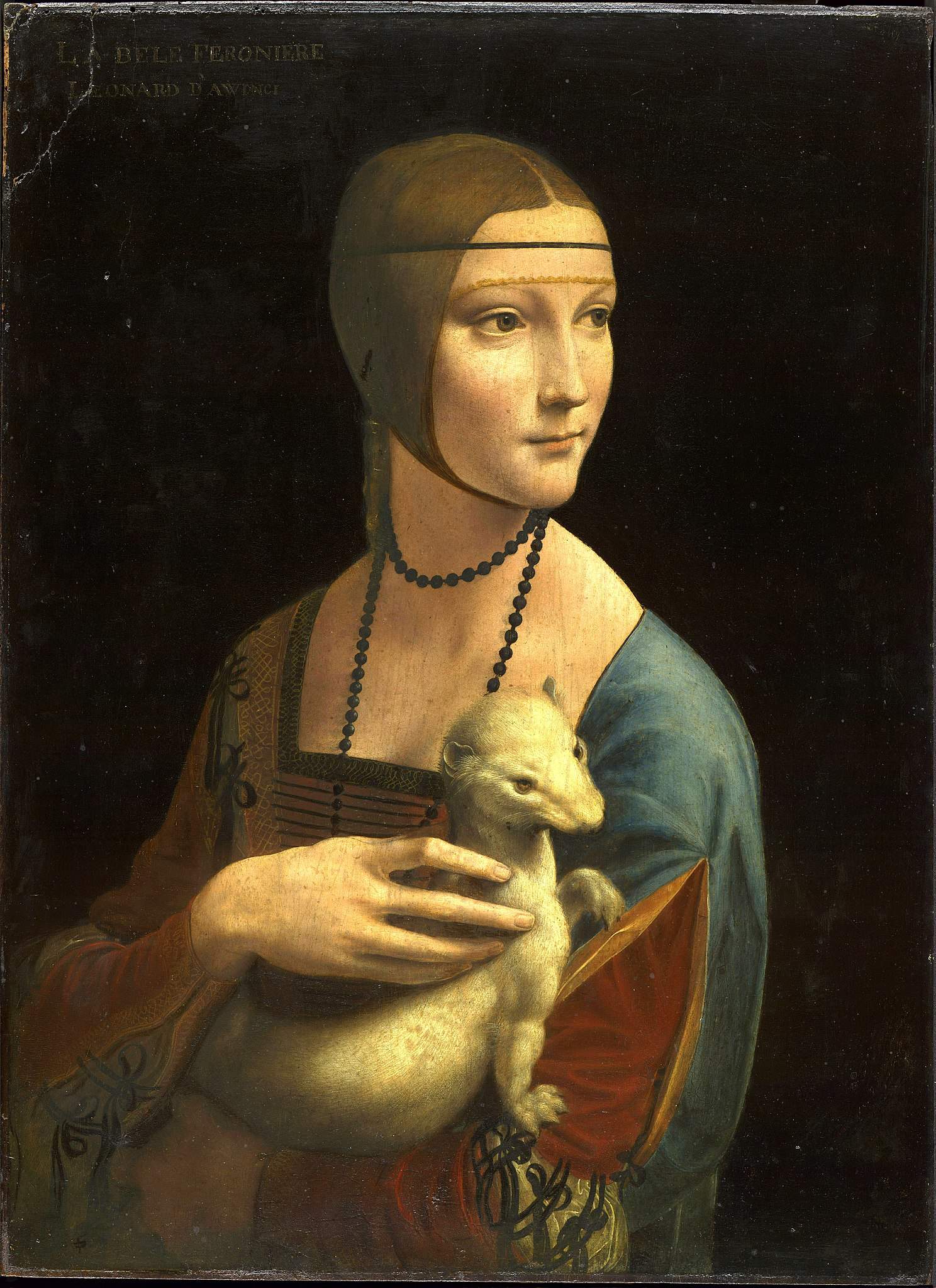
The Lady with an Ermine is an apparently very simple portrait: Cecilia Gallerani is depicted half-length, but in torsion (torso turned to the right, head to the left), and thus with the subject no longer all three-quarters as in earlier portraiture. The girl wears no jewelry, except for a black agate necklace worn as the fashion of the time dictated: a shorter loop around the neck and a wider one that falls instead over the breasts. The robe is neat but not luxurious: it is a velvet dress, with sleeves open according to the fashion of the time, and adorned with ribbons. Over her left shoulder the girl wears a bernia, a heavy cloth cloak typical of Spanish fashion of the time (in 1489 Isabella of Aragon married Gian Galeazzo Sforza, the Moor’s nephew, contributing to the spread of Spanish taste in dress in Milan), in this case a bright blue. Also reflected in Spanish fashion is the young woman’s particular hairstyle, known as coazzone or Spanish-style braid, which had been spreading in Italy for a few years, again starting in Aragonese Naples. Cecilia’s brown hair, gathered with a parting in the center, is held in place by a sheer gauze veil edged with braided gold threads, which in turn is fastened to her forehead with a black lace. At the nape of her neck we can also note the braid that runs down her neck. Her face is a practically perfect oval, which Leonardo leaves in full light so as not to conceal any detail from the eyes of the relative. Cecilia shows an expression that denotes a slight motion of surprise: we can see this from her intrigued eyes and her mouth, admirably painted with an exemplary essay of the typical Vincian sfumato, which hints at a smile, as well as from the movement of her neck as it turns, for the young woman is evidently distracted by someone who has just entered the room. The pale skin, with almost ebony tones, finds a correspondence in theermine’s coat, whose snow-white color alludes to the purity of the young woman: the animal, similarly moved by curiosity, is held firmly in her hands, with its body stretched out along the girl’s left arm, which acts as its support, and the long, tapering, realistic right hand, studied in every smallest anatomical detail (the folds of the skin, the bones, the tendons) that caresses it while at the same time avoiding making it shake.
Meanwhile, it can be noted that the young woman’s pose is unprecedented in Renaissance portraiture. Leonardo had already worked on a similar attitude in his Virgin of the Rocks, as attested not only by the painting itself but also by a Volto di fanciulla often identified as a preparatory study for the angel of the Virgin of the Rocks, preserved in the Royal Library in Turin, which would seem to be the most direct antecedent of the image of Ludovico Sforza’s young mistress. The pose is instrumental in unequivocally communicating the young woman’s state of mind: for art historian Cecil Gould we are in the presence of “the first portrait in modern history,” since this is the first portrait in which Leonardo da Vinci wished to give a concrete image of the motions of the soul, of the feelings felt by the young woman at the precise moment in which she is depicted: a moment of surprise, in this case. Leonardo had begun his research on the motions of the soul, the feelings that Leon Battista Alberti called “soul movements” in his De Pictura, at least starting with theAdoration of the Magi preserved in the Uffizi. The vincian would show that he adhered to the principles of Alberti’s science not only through his works, but also with what he left in writing: in fact, we read in the Treatise on Painting an indication to the reader-painter (“Farai le figure in tale atto, il quale sia sofficiente a dimostrare quello che la figura ha ne l’animo; altrimenti la tua arte non fia laudabile”) decisively indicative of his poetics, further explicated in his notes, notebooks, and notes. Also innovative is theluministic setting of the painting, a reflection of the studies that Leonardo conducted on the illumination of bodies: the light source is on the right and the glow from it invests Cecilia Gallerani’s adolescent face, her left shoulder, her hand and obviously the ermine’s muzzle, helping to enhance the three-dimensionality of the forms and also symbolically suggesting a continuity between the lady and the animal.
Interestingly, according to Pietro C. Marani, one of Leonardo da Vinci’s leading experts, the Lady with an Ermine is a work that “certainly [...] contributed to revolutionizing European portraiture.” The reasons for this revolution lie in a precise set of elements that make the image of this girl particularly vivid, who, as mentioned, seems almost distracted by the arrival of someone in her room, and who for that reason turns her gaze to her left, as does the animal she holds in her hands: “the result is therefore,” Marani writes, “a very vivid image, ’of the natural,’ extraordinarily innovative compared to the official portraits of the time, habitually showing the character inert and in profile. An admirable example of Leonardo’s painting technique (his fingerprints can also be discerned in it), it is also a painting rich in symbolic meanings, alluding not only to the virtues of the lady (’moderanza’, suggested by the black agate necklace, and chastity, suggested by the ermine), but also to Ludovico il Moro, himself likened to the ermine, who would rather die than lose his immaculacy: a courtly allusion to Ludovico’s moral qualities and the latter’s amorous union with the effigy.” We have no certainties, as mentioned above, about the commissioning of this painting, but it is assumed that it was Ludovico il Moro himself who commissioned Leonardo, evidently eager to admire him in private, which is why the image of Cecilia Gallerani appears to us so intimate, so far removed from official portraiture, especially since the girl is not wearing particularly elaborate or sumptuous robes: what interested the likely commissioner was to have before him a portrait that would communicate the virtues of his beloved, who is described in 1485, in a letter Ludovico il Moro sends to his brother, Cardinal Ascanio Sforza Visconti, as a young woman “notabile de sangue, honestissima et formossa quanto più havesse possuto desiderare.”
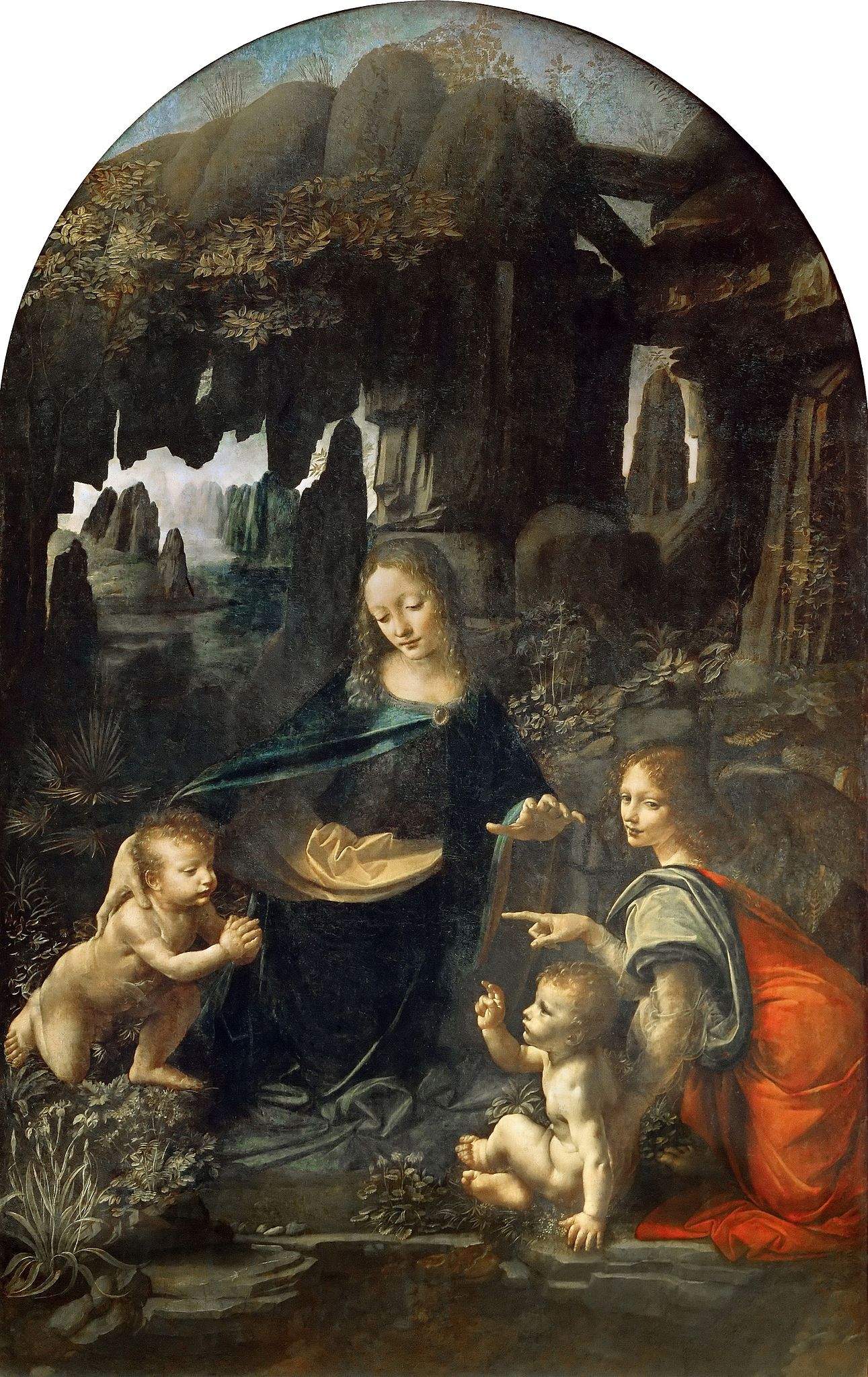
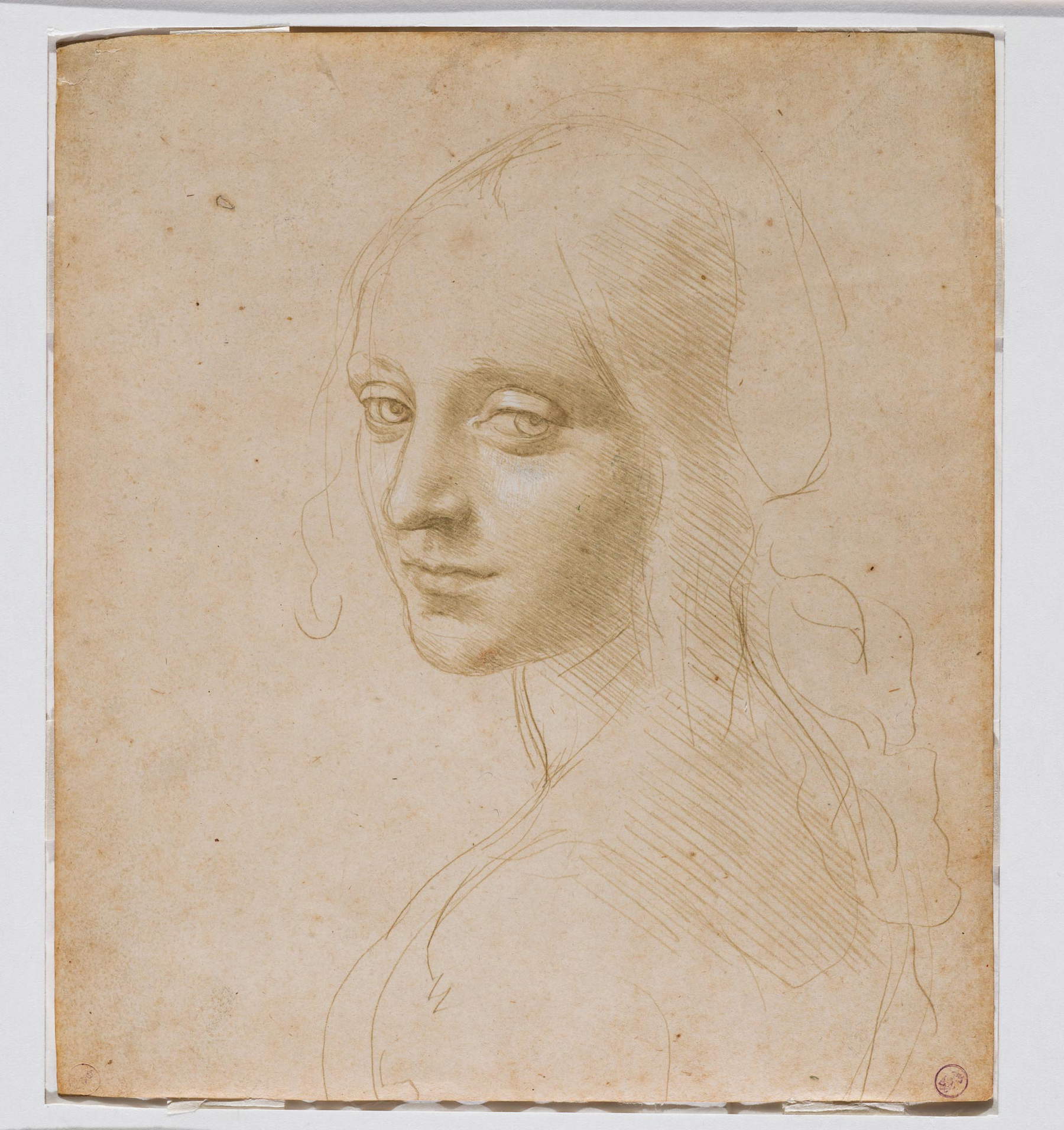
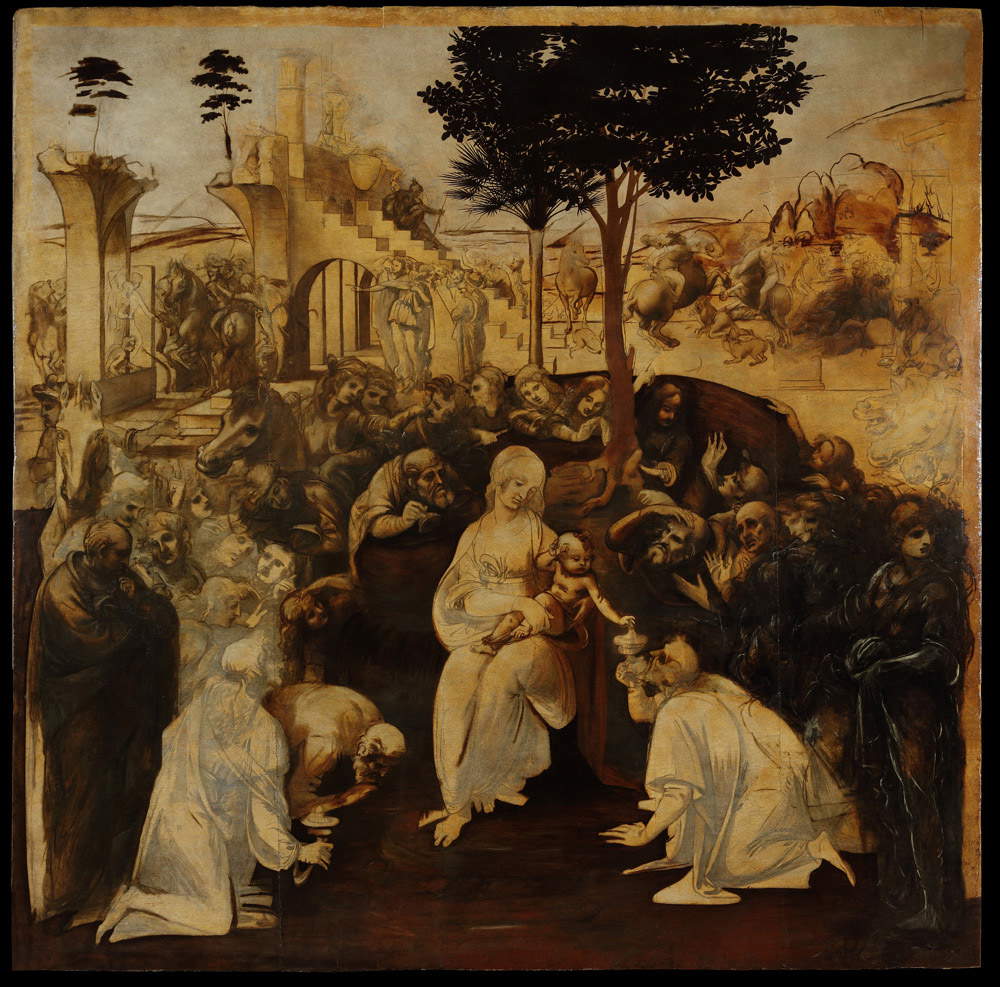
Suggesting a specific reference to Ludovico Sforza was Carlo Pedretti, who recalled how in 1488 the Moor had received from Ferrante of Aragon, King of Naples, the Order of the Ermine, a high honor of his kingdom, and consequently the portrait may have been a way of celebrating the event. But it may simply be the case that the ermine was included in the painting as a symbol of the lady’s qualities, not least because it is Leonardo himself who, in the so-called “bestiary” (three notebooks of notes on animals dating back to 1494), describes the alleged characteristics of the beast, stating that “prima vol morire che ’mbrattarsi” (thus alluding to the animal’s whiteness), and that “per la sua moderanza, non mangia se non una volta al dì, e prima si lascia pigliare a’ cacciatori che voler fuggire nella infangata tana,” so as “not to maculate its kindness.” There is, moreover, a drawing preserved at the Fitzwilliam Museum in Cambridge in which Leonardo depicts an ermine surrendering to the hunters precisely to avoid soiling itself by taking refuge in the den. Curiously, an apocryphal inscription, probably added in the nineteenth century (“La bele feroniere / Leonard D’Awinci”) can also be seen appearing in the left-hand corner of the portrait, which has led to speculation in the past that the painting depicted Madame Ferron, mistress of King Francis I of France: the same identity, moreover, formerly attributed to another of Leonardo da Vinci’s most famous portraits, the one known as “La Belle Ferronnière” from a note appearing in an eighteenth-century inventory, and for which the problem of identifying the lady depicted is decidedly more complex than the Lady with an Ermine (moreover, there has been no shortage of those who have argued that the painting now in the Louvre also depicts Cecilia Gallerani).
The novelty of Leonardo’s portrait did not take long to manifest itself in Milanese artistic circles, and even beyond the borders of the duchy. Among the earliest and most punctual derivations it is possible to include Bernardino Luini ’s Magdalene (Dumenza, c. 1480 - Milan, 1532), whose pose (especially looking at the attitude her body assumes) immediately brings to mind Leonardo’s masterpiece. Luini, moreover, in a sheet now in the Biblioteca Ambrosiana in Milan, copied, albeit specularly, the face of the Lady with an ermine, further proof of the fortune of Leonardo da Vinci’s work. However, the first work that seems to refer directly to the Lady with an Ermine seems to be the Portrait of a Gentlewoman by Giovanni Antonio Boltraffio (Milan, 1467 - 1516), one of Leonardo’s major works: coming from the collection of the noble Milanese Pusterla family, it has been believed to be a portrait of Clarice Pusterla, another friend of Ludovico il Moro, although the identity of the young woman could never be ascertained with certainty. Boltraffio departs from the master by introducing a downward movement of the neck (in order to avoid the crossing of glances with the observer, thus making the portrait more elusive), the same that will be taken up in Lorenzo Costa ’s Lady with a Dog (Ferrara, 1460 - Mantua, 1535), now preserved at Hampton Court, another painting that is quite clearly influenced by the Lady with an Ermine. The Ferrara artist’s work is often identified with what Isabella d’Este (who had insistently requested a portrait from Leonardo: would have succeeded, however, in obtaining, when the Tuscan stayed in Mantua between 1499 and 1500, only a cartoon, now in the Louvre) would have asked him with the express “task of translating the articulate portrait of Cecilia Gallerani into a more domestic domestic portrait of her, in which the marquise wished to be depicted with a small dog,” as Marani writes, reiterating, however, that neither Boltraffio’s nor Costa’s painting even remotely achieves the introspective qualities of the Lady with an ermine, which instead succeeds in communicating, “to the highest degree,” the character’s “motion of mind.” And yet, Marani rightly notes, from Boltraffio and Costa “no more could be expected.” Toward the beginning of the sixteenth century, however, the fame of Leonardo’s portrait must have spread to the point of launching a fashion, with the ermine replaced by a dog, and for which Lorenzo Costa’s painting itself constituted a sort of initiator. Moreover, Cecilia Gallerani’s face, as Luini’s own drawing attests, ended up becoming a model of beauty for the entire circle of Leonardo artists.
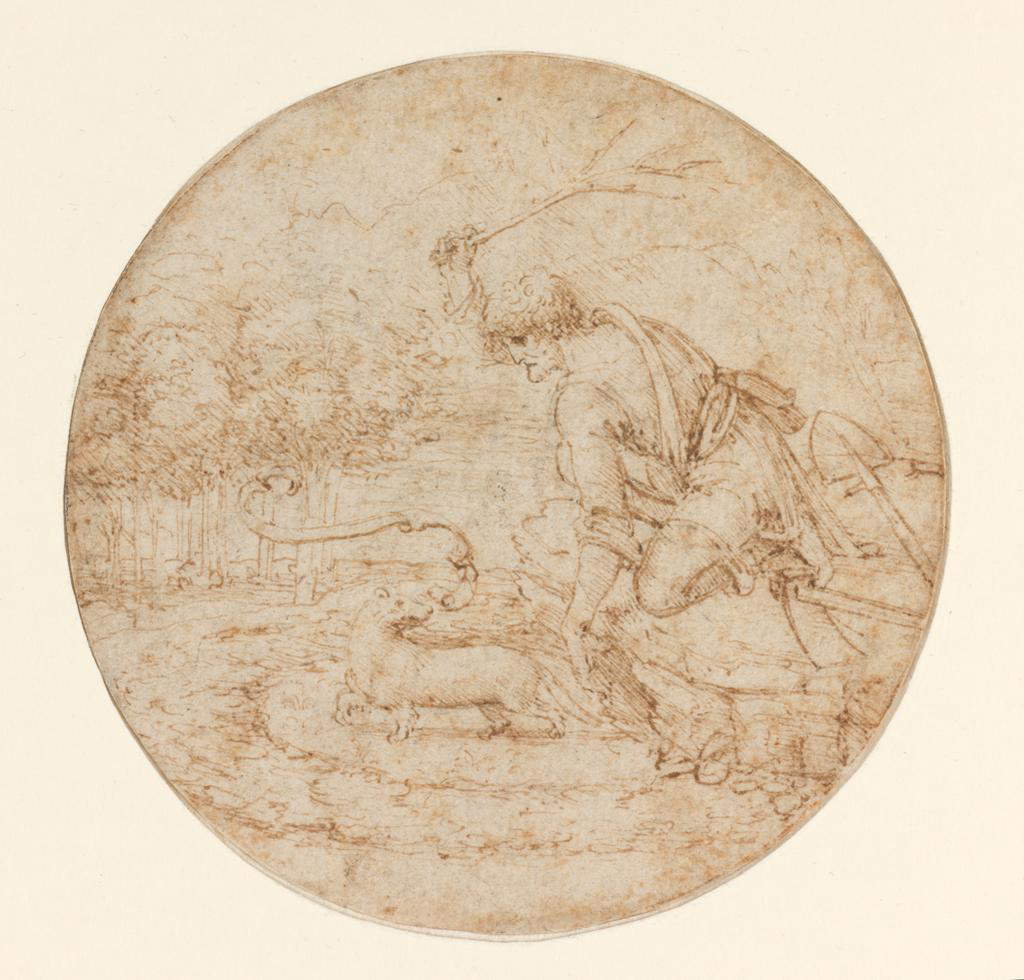
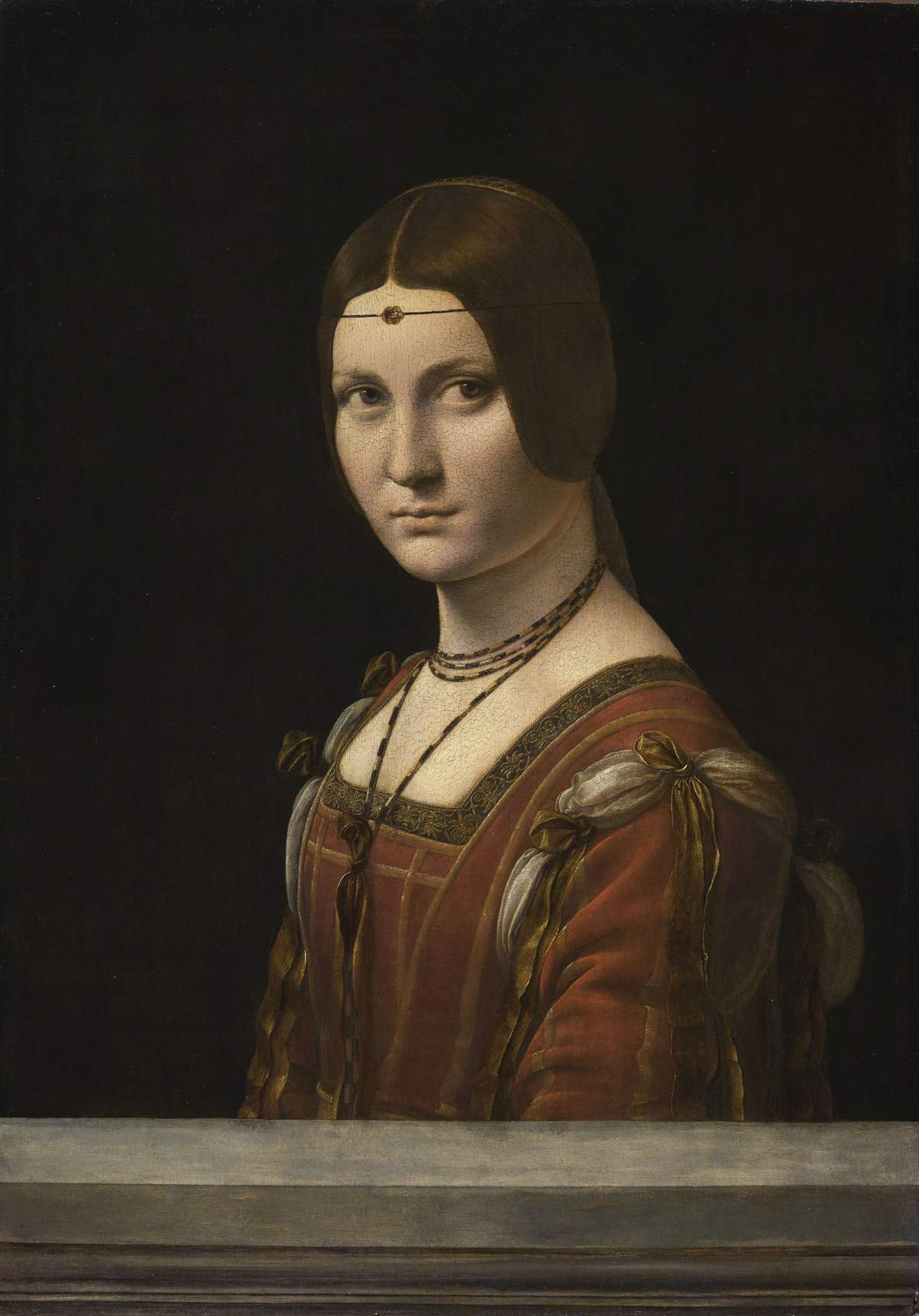
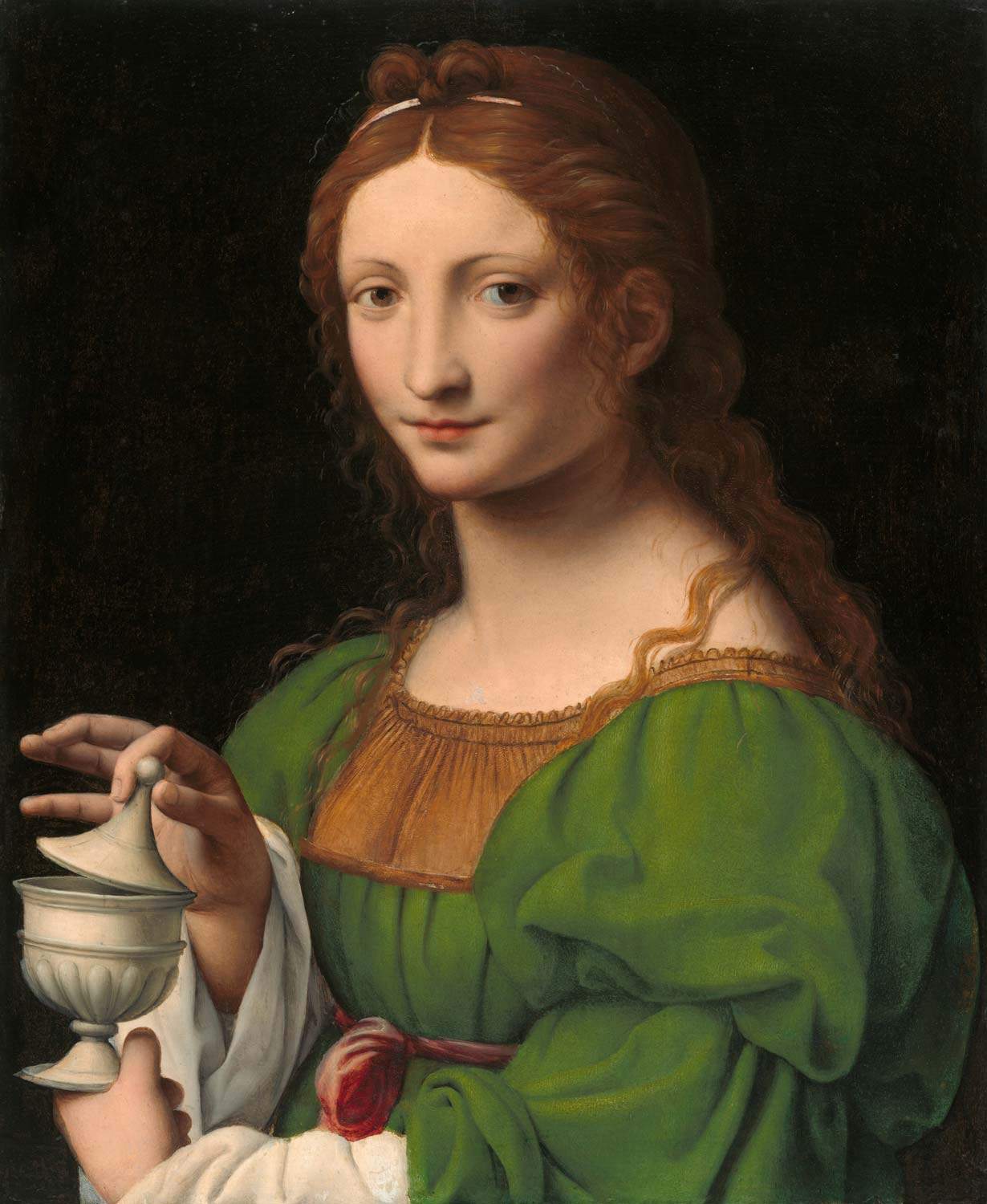
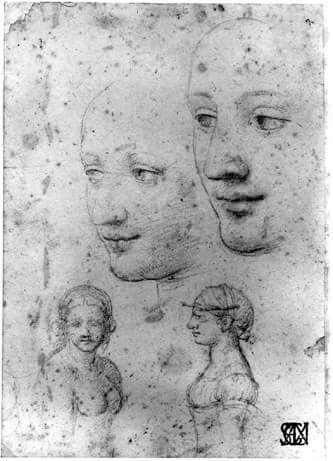
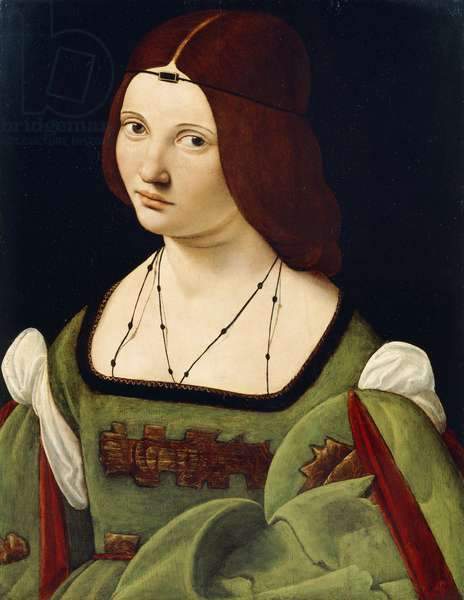
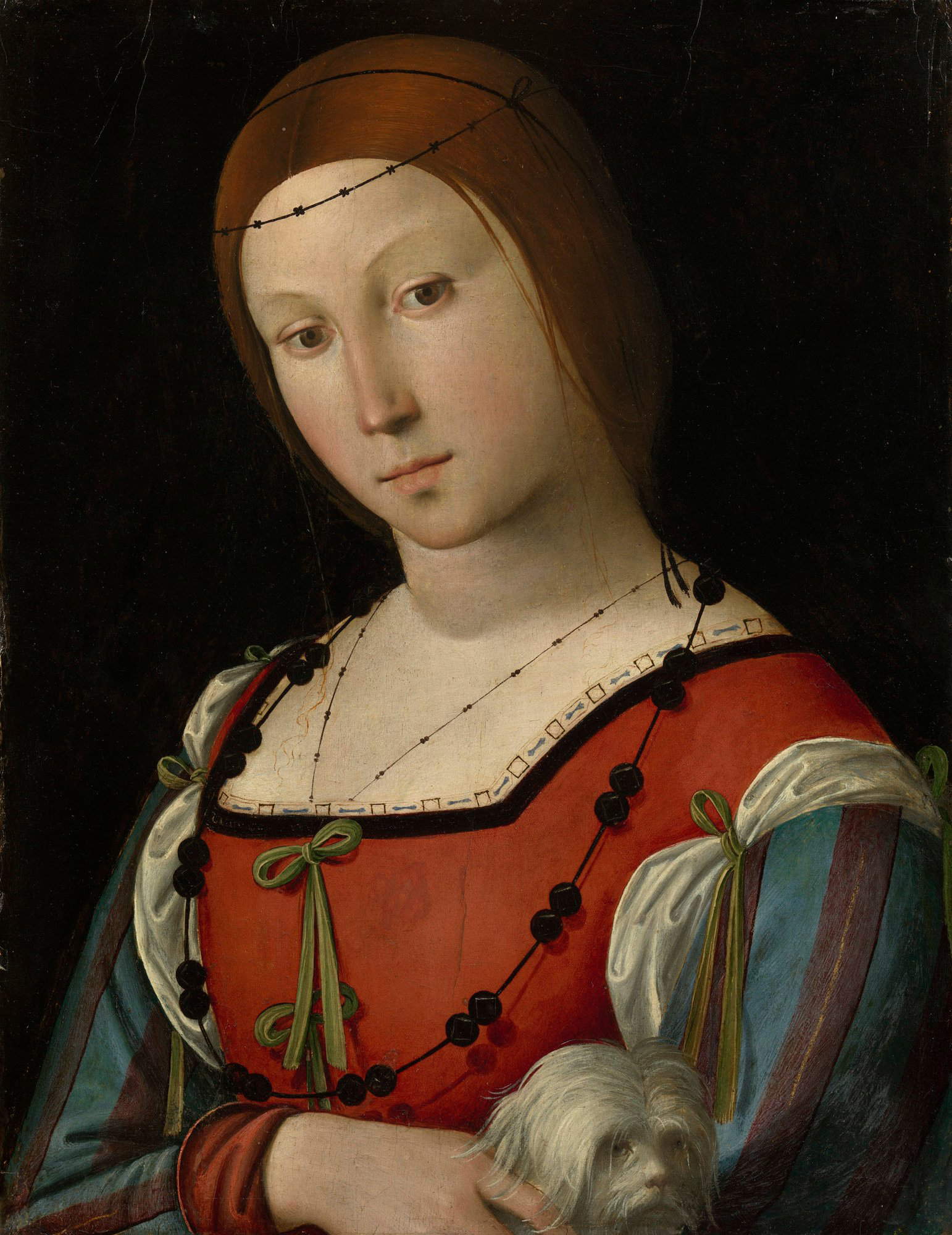
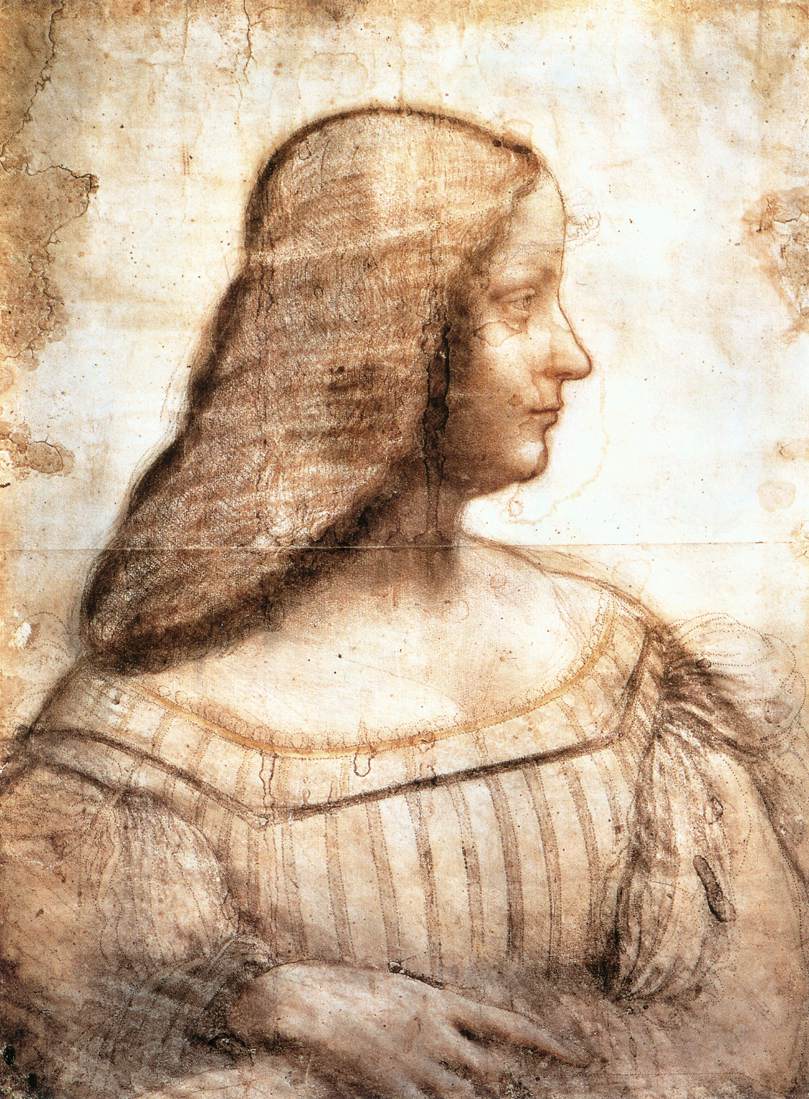
However, one question has not been answered: who was Cecilia Gallerani? As anticipated, she found herself to be Moro’s mistress when she was not yet fifteen years old, although at the time a relationship between such a young girl and a decidedly more mature man was not considered strange or improper. She was a noblewoman from a family of Sienese descent: her grandfather, Sigerio, had left Siena for political reasons, taking refuge in Milan, and his son Fazio, that is, Cecilia’s father, was a high dignitary in the Milanese court. The girl, at only ten years old, had already been betrothed by her mother Margherita to the nobleman Giovanni Stefano Visconti, another man much older than Cecilia (the two were separated by an age difference of twenty-four years). The promise would, however, be dissolved in 1487, for reasons still to be ascertained: perhaps precisely because the family saw the possibility of Cecilia marrying Ludovico il Moro, who, however, at the time was already engaged to Beatrice d’Este, a young daughter of the Duke of Ferrara, later married in 1491, although it was a marriage of which the Moor was anything but enthusiastic (he did not even know his fiancée until shortly before the wedding). It is not known when the love affair between Cecilia and the future duke began, but based on the letter mentioned above, it is likely that the liaison between the two had already begun by that time, between 1484 and 1485. However, we know for certain from documents of the time that Cecilia was present at the Sforza court in 1489. Two years later, Cecilia was to give birth to a son by Ludovico: Cesare Sforza, who later became abbot of the basilica of San Nazaro in Brolo in Milan, and portrayed perhaps, as a child, by the Master of the Pala Sforzesca in his famous altarpiece preserved at the Brera Art Gallery. Precisely on the occasion of the birth of her son Cecilia, who up to that time was still living at court without apparently creating too many problems for Beatrice d’Este (even Cesare’s birth was not hidden, although it could not be legitimized), was removed to avoid unseemly situations, but in return she received substantial donations, above all the fief of Saronno. She then went to live in San Giovanni in Croce, having married Count Ludovico Carminati, who was feudatory of the Cremonese locality. Cecilia spent a serene existence: a cultured woman, a lover of the arts and letters, she had relations with many of the great men of letters of the time (starting with the aforementioned Bernardo Bellincioni), was a friend of Isabella d’Este, as seen from the letters cited above, and disappeared in 1533 in San Giovanni in Croce, which she had not left since the date of her marriage.
Decidedly more obscure, however, are the ancient events of the painting so much so that, as mentioned, there is not even mathematical certainty that the Lady with an Ermine is actually the portrait of Cecilia Gallerani, although the probability is very high. All that is known is that the painting was purchased on the Italian antiquities market in 1798 by Polish Prince Adam Jerzy Czartoryski, and has since become a permanent part of the family collections, which gave rise to the Czartoryski Museum in Krakow. The painting, after its purchase, had a troubled life, risking a bad end several times: during the November Uprising, the 1830 rebellion of Poles against the Russians, the Lady with an Ermine was taken out of Kraków, in the direction of Sieniawa, further south, to shelter it from looting. Following the family’s exile, the work ended up in Paris and returned to Poland in 1869, when the Czartoryskis were able to return to their native country. In 1878 the museum opened its doors, but the opera’s vicissitudes were not over, since it was moved to Dresden during World War I, again to secure it from looting, and could only return to Krakow in 1920. Another risk was taken at the dawn of the Nazi invasion of Poland: the family chose to take the painting back to Sieniawa, but that was not enough: the Germans discovered Leonardo’s masterpiece, seized it, and sent it to the Kaiser Friedrich Museum in Berlin. It could only return to Poland in 1940, but it was not returned to its rightful owners: simply, the governor-general of occupied Poland, Hans Frank, wanted it hung in his office inside Wavel Castle. Even after the war Frank kept the work to himself: in fact, it was found only after the war was over at his country home in Schliersee, Bavaria, and in 1946 it was finally returned to the Czartoryski Museum. Thereafter, fortunately, the work moved only in exhibitions (twice also in Italy: in Rome and Milan in 1998 and in Florence, in 1999), most recently between 2017 and 2019, at the National Museum in Krakow, when the Czartoryski Museum was closed for restoration work. The latest chapter in its history is the nationalization of the painting: the Princes Czartoryski Foundation, which owns the painting and is represented by the last descendant of Adam Jerzy, namely Prince Adam Karol, in fact sold the Lady with an Ermine along with the entire family collection for the sum of 100 million euros to the government of Poland in 2016. The transaction caused controversy, since the amount was considered excessively low compared to the value of the collection: however, since then the Lady with an Ermine has become Poland’s national heritage. And so it is at the Czartoryski Museum that, from December 29, 2019, it is again possible to admire one of the all-time masterpieces of portraiture.
Warning: the translation into English of the original Italian article was created using automatic tools. We undertake to review all articles, but we do not guarantee the total absence of inaccuracies in the translation due to the program. You can find the original by clicking on the ITA button. If you find any mistake,please contact us.